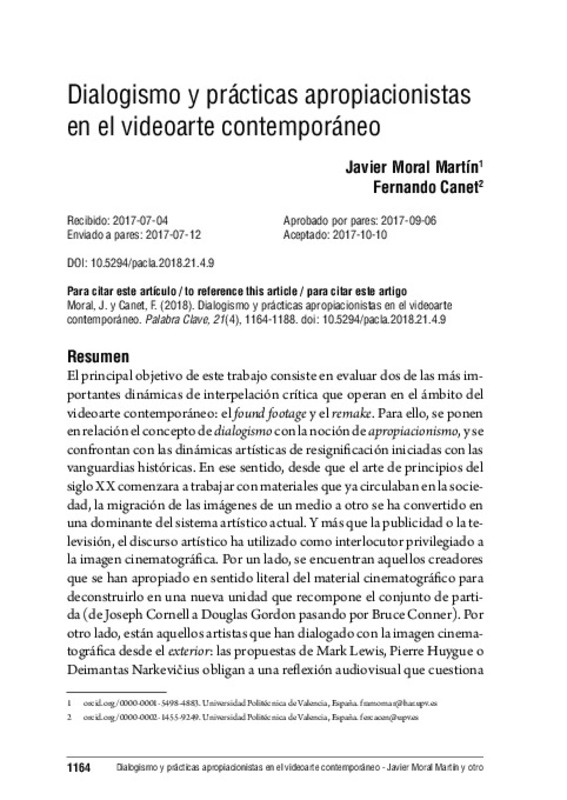JavaScript is disabled for your browser. Some features of this site may not work without it.
Buscar en RiuNet
Listar
Mi cuenta
Estadísticas
Ayuda RiuNet
Admin. UPV
Dialogismo y prácticas apropiacionistas en el videoarte contemporáneo
Mostrar el registro sencillo del ítem
Ficheros en el ítem
| dc.contributor.author | Moral Martin, Francisco Javier
|
es_ES |
| dc.contributor.author | Canet Centellas, Fernando Javier
|
es_ES |
| dc.date.accessioned | 2019-09-14T20:01:19Z | |
| dc.date.available | 2019-09-14T20:01:19Z | |
| dc.date.issued | 2018 | es_ES |
| dc.identifier.issn | 0122-8285 | es_ES |
| dc.identifier.uri | http://hdl.handle.net/10251/125680 | |
| dc.description.abstract | [EN] The main objective of this work is to evaluate two of the most important aspects of critical interpellation that operate in the field of contemporary video art: found footage and remakes. To do so, the authors relate the concept of dialogism to the notion of appropriationism, and look at them in light of the artistic dynamics of resignification initiated with the avant-garde movements of the past. In that respect, ever since the art of the early XX century began to work with materials that were already circulating in society, the migration of images from one medium to another has become a dominant feature of the current artistic system. And, more than advertising or television, the artistic discourse has used the cinematographic image as a privileged interlocutor. On the one hand, there are those creators who have appropriated cinematographic material in a literal sense, in order to deconstruct it into a new unit that recomposes the starting set (from Joseph Cornell to Douglas Gordon through Bruce Conner). On the other hand, there are those artists who have disscused with the cinematographic image from the outside: the proposals of Mark Lewis, Pierre Huygue or Deimantas Narkevicius demand audiovisual reflection that questions the concepts of originality and copy, essential elements of both aesthetic transformation, as well as the aesthetic experience referred to a subject. However, the same conclusion can be reached in both cases: if the contemporary artistic image is characterized by its ethereal and roving condition, it is the cinematic spirit that seems to animate it. | es_ES |
| dc.description.abstract | [ES] El principal objetivo de este trabajo consiste en evaluar dos de las más importantes dinámicas de interpelación crítica que operan en el ámbito del videoarte contemporáneo: el found footage y el remake. Para ello, se ponen en relación el concepto de dialogismo con la noción de apropiacionismo, y se confrontan con las dinámicas artísticas de resignificación iniciadas con las vanguardias históricas. En ese sentido, desde que el arte de principios del siglo XX comenzara a trabajar con materiales que ya circulaban en la sociedad, la migración de las imágenes de un medio a otro se ha convertido en una dominante del sistema artístico actual. Y más que la publicidad o la televisión, el discurso artístico ha utilizado como interlocutor privilegiado a la imagen cinematográfica. Por un lado, se encuentran aquellos creadores que se han apropiado en sentido literal del material cinematográfico para deconstruirlo en una nueva unidad que recompone el conjunto de partida (de Joseph Cornell a Douglas Gordon pasando por Bruce Conner). Por otro lado, están aquellos artistas que han dialogado con la imagen cinematográfica desde el exterior: las propuestas de Mark Lewis, Pierre Huygue o Deimantas Narkevi¿ius obligan a una reflexión audiovisual que cuestiona los conceptos de originalidad y copia, elementos esenciales tanto del devenir estético como de la experiencia estética referida a un sujeto. En ambos casos, no obstante, puede llegarse a una misma conclusión: si la imagen artística contemporánea se caracteriza por su condición fantasmal y errante, es el espíritu cinematográfico lo que parece animarla. | es_ES |
| dc.language | Español | es_ES |
| dc.publisher | Universidad de La Sabana | es_ES |
| dc.relation.ispartof | Palabra Clave | es_ES |
| dc.rights | Reserva de todos los derechos | es_ES |
| dc.subject | Video art | es_ES |
| dc.subject | Footage found | es_ES |
| dc.subject | Appropriationism | es_ES |
| dc.subject | Remake | es_ES |
| dc.subject | Ready-mades | es_ES |
| dc.subject | Found footage | es_ES |
| dc.subject.classification | COMUNICACION AUDIOVISUAL Y PUBLICIDAD | es_ES |
| dc.title | Dialogismo y prácticas apropiacionistas en el videoarte contemporáneo | es_ES |
| dc.title.alternative | Dialogism and Appropriationist Practices in Contemporary Video Art | es_ES |
| dc.type | Artículo | es_ES |
| dc.identifier.doi | 10.5294/pacla.2018.21.4.9 | es_ES |
| dc.rights.accessRights | Abierto | es_ES |
| dc.contributor.affiliation | Universitat Politècnica de València. Departamento de Comunicación Audiovisual, Documentación e Historia del Arte - Departament de Comunicació Audiovisual, Documentació i Història de l'Art | es_ES |
| dc.description.bibliographicCitation | Moral Martin, FJ.; Canet Centellas, FJ. (2018). Dialogismo y prácticas apropiacionistas en el videoarte contemporáneo. Palabra Clave. 21(4):1164-1188. https://doi.org/10.5294/pacla.2018.21.4.9 | es_ES |
| dc.description.accrualMethod | S | es_ES |
| dc.relation.publisherversion | http://doi.org/10.5294/pacla.2018.21.4.9 | es_ES |
| dc.description.upvformatpinicio | 1164 | es_ES |
| dc.description.upvformatpfin | 1188 | es_ES |
| dc.type.version | info:eu-repo/semantics/publishedVersion | es_ES |
| dc.description.volume | 21 | es_ES |
| dc.description.issue | 4 | es_ES |
| dc.relation.pasarela | S\387028 | es_ES |








